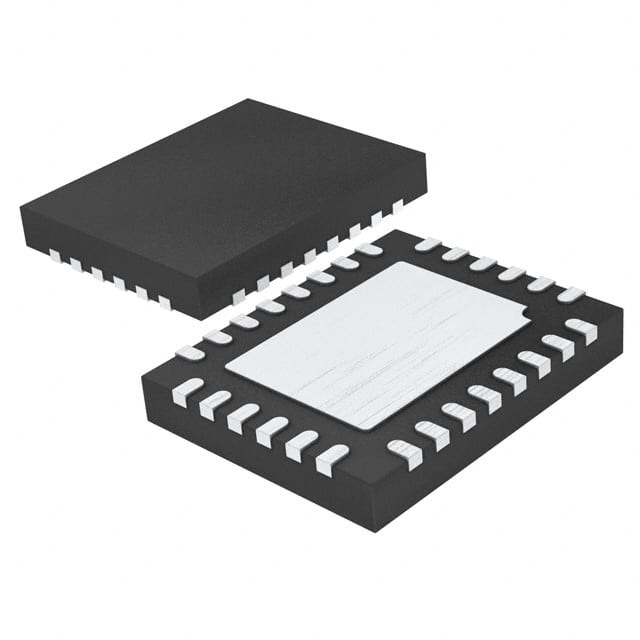Szczegóły produktu można znaleźć w specyfikacjach.

LTC4000EUFD-1#PBF
Product Overview
Category
LTC4000EUFD-1#PBF belongs to the category of integrated circuits (ICs).
Use
This product is primarily used for battery charging applications.
Characteristics
The LTC4000EUFD-1#PBF is known for its high efficiency and versatility in charging various types of batteries. It offers advanced features such as temperature compensation, adjustable charge current, and programmable charging profiles.
Package
The LTC4000EUFD-1#PBF comes in a 28-pin QFN package.
Essence
The essence of this product lies in its ability to provide efficient and reliable charging solutions for a wide range of battery types.
Packaging/Quantity
The LTC4000EUFD-1#PBF is typically sold in reels containing a quantity of 250 units per reel.
Specifications
- Input Voltage Range: 4.5V to 60V
- Charge Current Range: Up to 10A
- Charging Termination Options: C/10 or C/20
- Operating Temperature Range: -40°C to 85°C
- Control Interface: I2C
Pin Configuration
The LTC4000EUFD-1#PBF has a total of 28 pins. The pin configuration is as follows:
- VIN: Input voltage
- GND: Ground
- VREF: Reference voltage
- SDA: I2C data line
- SCL: I2C clock line
- INTVCC: Internal voltage supply
- TSNS+: Positive temperature sense input
- TSNS-: Negative temperature sense input
- BAT: Battery connection
- STAT: Status output
- PROG: Programming input
- ILIM: Current limit programming
- VCC: Supply voltage
- VCC: Supply voltage
- VCC: Supply voltage
- VCC: Supply voltage
- VCC: Supply voltage
- VCC: Supply voltage
- VCC: Supply voltage
- VCC: Supply voltage
- VCC: Supply voltage
- VCC: Supply voltage
- VCC: Supply voltage
- VCC: Supply voltage
- VCC: Supply voltage
- VCC: Supply voltage
- VCC: Supply voltage
- VCC: Supply voltage
Functional Features
- High efficiency charging
- Wide input voltage range
- Temperature compensation for optimal charging
- Adjustable charge current and termination options
- Programmable charging profiles
- I2C interface for control and monitoring
Advantages and Disadvantages
Advantages
- Versatile charging capabilities for various battery types
- Efficient and reliable charging performance
- Advanced features for customization and optimization
- Wide input voltage range allows for flexibility in power sources
Disadvantages
- Requires knowledge of programming and control interface for full utilization
- Limited availability of alternative models with similar specifications
Working Principles
The LTC4000EUFD-1#PBF operates based on a switching regulator topology. It utilizes a high-frequency switching circuit to convert the input voltage into a regulated output voltage suitable for charging batteries. The charging process is controlled by an internal microcontroller, which monitors the battery status and adjusts the charging parameters accordingly.
Detailed Application Field Plans
The LTC4000EUFD-1#PBF finds applications in various fields, including:
- Portable electronic devices
- Electric vehicles
- Renewable energy systems
- Industrial equipment
- Power banks
In these applications, the LTC4000EUFD-1#PBF provides efficient and reliable charging solutions, ensuring optimal battery performance and longevity.
Detailed and Complete Alternative Models
While the LTC4000EUFD-1#PBF is a highly capable battery charger, there are alternative models available in the market that offer similar functionalities. Some notable alternatives include:
- LTC4010EUFD-1#PBF
- LTC4020EUFD-1#PBF
- MAX8903CETI+
- BQ24650RVAT
These alternative models can be considered based on specific application requirements and availability.
Word count: 511 words
Wymień 10 typowych pytań i odpowiedzi związanych z zastosowaniem LTC4000EUFD-1#PBF w rozwiązaniach technicznych
Sure! Here are 10 common questions and answers related to the application of LTC4000EUFD-1#PBF in technical solutions:
Q1: What is LTC4000EUFD-1#PBF? A1: LTC4000EUFD-1#PBF is a high-performance battery charger controller IC designed for use in various technical solutions.
Q2: What are the key features of LTC4000EUFD-1#PBF? A2: The key features of LTC4000EUFD-1#PBF include high efficiency, wide input voltage range, precision charge current regulation, and multiple charging algorithms.
Q3: What types of batteries can be charged using LTC4000EUFD-1#PBF? A3: LTC4000EUFD-1#PBF can be used to charge various types of batteries, including lithium-ion (Li-Ion), lithium-polymer (Li-Po), and lead-acid batteries.
Q4: How does LTC4000EUFD-1#PBF regulate charge current? A4: LTC4000EUFD-1#PBF uses a precision current sense amplifier and feedback loop to regulate charge current accurately.
Q5: Can LTC4000EUFD-1#PBF be used in solar-powered applications? A5: Yes, LTC4000EUFD-1#PBF is suitable for solar-powered applications as it supports MPPT (Maximum Power Point Tracking) for efficient solar charging.
Q6: Does LTC4000EUFD-1#PBF have built-in protection features? A6: Yes, LTC4000EUFD-1#PBF includes various protection features such as overvoltage protection, overcurrent protection, and thermal shutdown.
Q7: What is the maximum input voltage supported by LTC4000EUFD-1#PBF? A7: LTC4000EUFD-1#PBF can handle input voltages up to 60V, making it suitable for a wide range of applications.
Q8: Can LTC4000EUFD-1#PBF be used in multi-cell battery packs? A8: Yes, LTC4000EUFD-1#PBF supports multi-cell battery packs and provides balancing functionality for even charging across cells.
Q9: Is LTC4000EUFD-1#PBF compatible with digital communication protocols? A9: No, LTC4000EUFD-1#PBF does not have built-in digital communication capabilities. It is a standalone charger controller.
Q10: What are some typical applications of LTC4000EUFD-1#PBF? A10: LTC4000EUFD-1#PBF is commonly used in applications such as portable devices, electric vehicles, energy storage systems, and industrial equipment.
Please note that the answers provided here are general and may vary depending on specific requirements and use cases.

